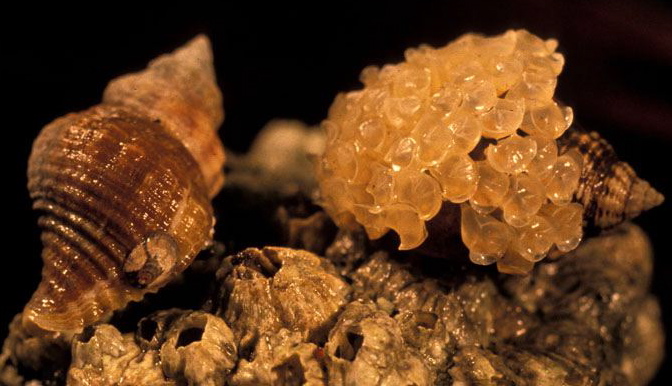Science News
The Male Snail's Burden
September 6, 2012

“If he wants to get any action, he has to pay the price.” That’s Rick Grosberg of UC Davis talking about male marine snails, Solenosteira macrospira.
Grosberg started studying the animals in 1994. He brought some back from a collecting trip in Baja California and realized that only male snails had egg capsules on their shells. This is rare in the animal kingdom, where females usually do all of the work in childcare. So Grosberg did a little investigating.
He and his colleagues discovered that when the snails mate, the female glues capsules containing hundreds of eggs to the male’s shell. The shell likely acts as a substitute rock, since the snails’ habitat offers few surfaces on which to glue eggs. Moving in and out with the tide on dad’s back also protects the egg capsules from the extremes of heat and drying they might face if left on a stationary rock.
A male’s shell may become covered in dozens of capsules, each containing up to 250 eggs. The scientists observed that these capsules can be heavy—the mail snails tend to lose weight in the process.
As the eggs hatch, some of the baby snails devour the rest of their littermates. Typically only a handful of hatchlings survives the fratricide to emerge from a capsule and crawl away.
And here’s where it gets weird: only one in four of the average 250 capsules of eggs that a male S. macrospira carries around on his back belong to him. Some carry the offspring of as many as 25 other males.
“The promiscuity in the female snails is extraordinary,” says Grosberg’s postdoc Stephanie Kamel.
So why the heck does the male snail schlep other males’ offspring around? It may be that carrying the egg capsules simply represents the best of limited options for the males, Grosberg says, since it’s impossible for them to mate without the female attaching an egg capsule to their backs.
It also might be a way for a male to show a female that he’s good parent material. And as Grosberg infers in the opening quote, the cost is worth it.
The study was recently published in Ecology Letters.
Image: Rick Grosberg